
Creative Commons Attribution-Noncommercial-No Derivative Works 3.0
Plate 2.43: Roman Pavements Found Near Warminster (Original Explanatory Account)
1 2020-06-27T11:45:02+00:00 Ariel Fried f6b6cec26c5a46c3beae9e3505bac9e8799f51de 31 15 Original Explanatory Account for Vetusta Monumenta, Plate 2.43. Written by Richard Gough. plain 2021-04-19T01:52:51+00:00 Noah Heringman ed5eca6418903b1281787a0c30645d943ca84184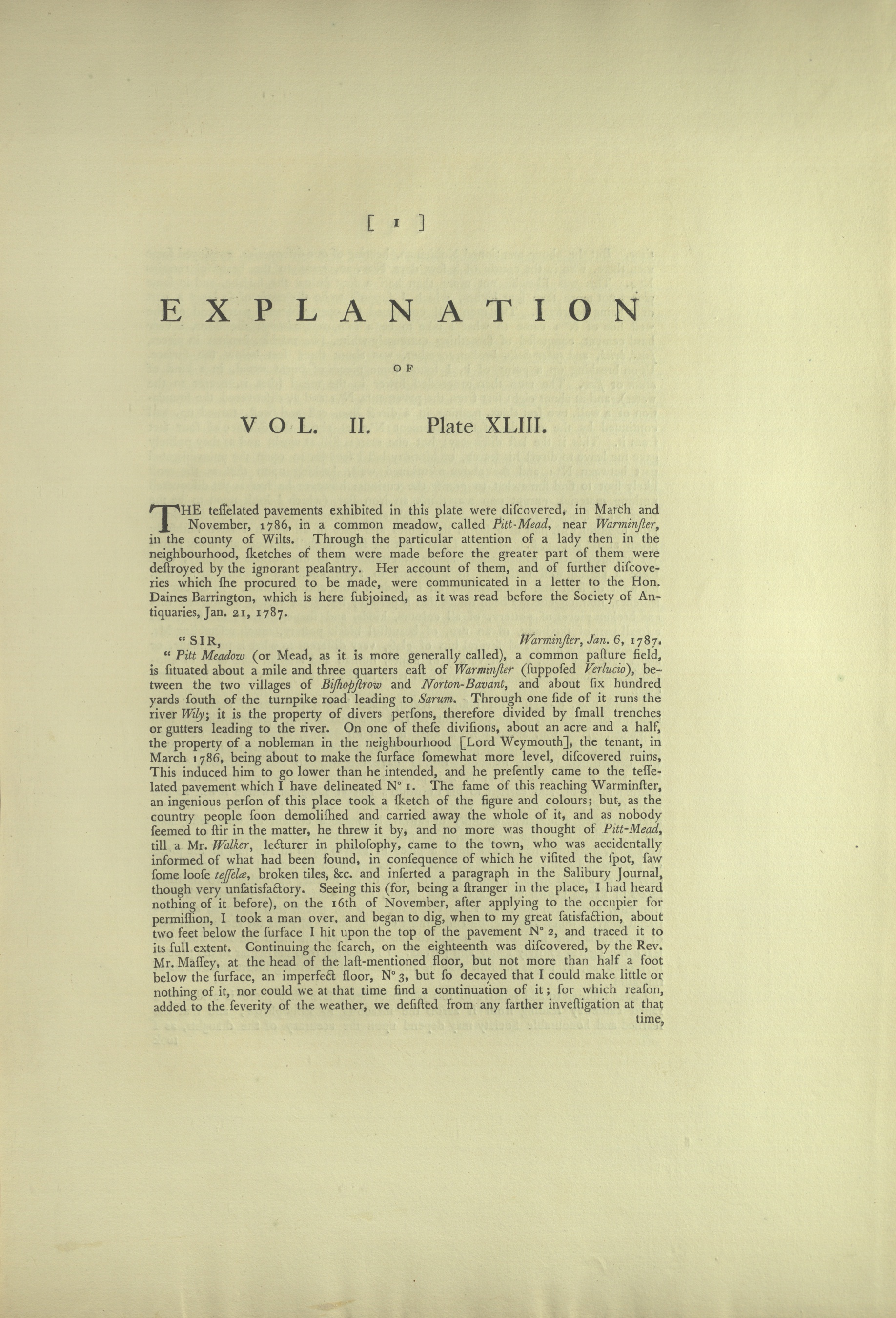
[ (Page) 1 ]
EXPLANATION OF VOL. II. Plate XLIII.
THE tesselated pavements exhibited in this plate were discovered, in March and November, 1786, in a common meadow, called Pitt-Mead, near Warminster, in the county of Wilts. Through the particular attention of a lady then in the neighbourhood, sketches of them were made before the greater part of them were destroyed by the ignorant peasantry.
Read more/less…
Her account of them, and of further discoveries which she procured to be made, were communicated in a letter to the Hon. Daines Barrington, which is here subjoined, as it was read before the Society of Antiquaries, Jan. 21, 1787.
Warminster, Jan. 6, 1787.
"Sir
“Pitt Meadow (or Mead, as it is more generally called), a common pasture field, is situated about a mile and three quarters east of Warminster (supposed Verlucio), between the two villages of Bishopsrow and Norton-Bavant, and about six hundred yards south of the turnpike road leading to Sarum. Through one side of it runs the river Wily; it is the property of divers persons, therefore divided by small trenches or gutters leading to the river. On one of these divisions, about an acre and a half, the property of a nobleman in the neighbourhood [Lord Weymouth], the tenant, in March 1786, being about to make the surface somewhat more level, discovered ruins[.] This induced him to go lower than he intended, and he presently came to the tesselated pavement which I have delineated No 1. The fame of this reaching Warminster, an ingenious person of this place took a sketch of the figure and colours; but, as the country people soon demolished and carried away the whole of it, and as nobody seemed to stir in the matter, he threw it by, and no more was thought of Pitt-Mead, till a Mr. Walker, lecturer in philosophy, came to the town, who was accidentally informed of what had been found, in consequence of which he visited the spot, saw some loose tesselae, broken tiles, &c. and inserted a paragraph in the Salisbury Journal, though very unsatisfactory. Seeing this (for, being a stranger in the place, I had heard nothing of it before), on the 16th of November, after applying to the occupier for permission, I took a man over, and began to dig, when to my great satisfaction, about two feet below the surface I hit upon the top of the pavement No 2, and traced it to its full extent. Continuing the search, on the eighteenth was discovered, by the Rev. Mr. Massey, at the head of the last-mentioned floor, but not more than half a foot below the surface, an imperfect floor, No 3, but so decayed that I could make little or nothing of it, nor could we at that time find a continuation of it; for which reason, added to the severity of the weather, we desisted from any farther investigation at that
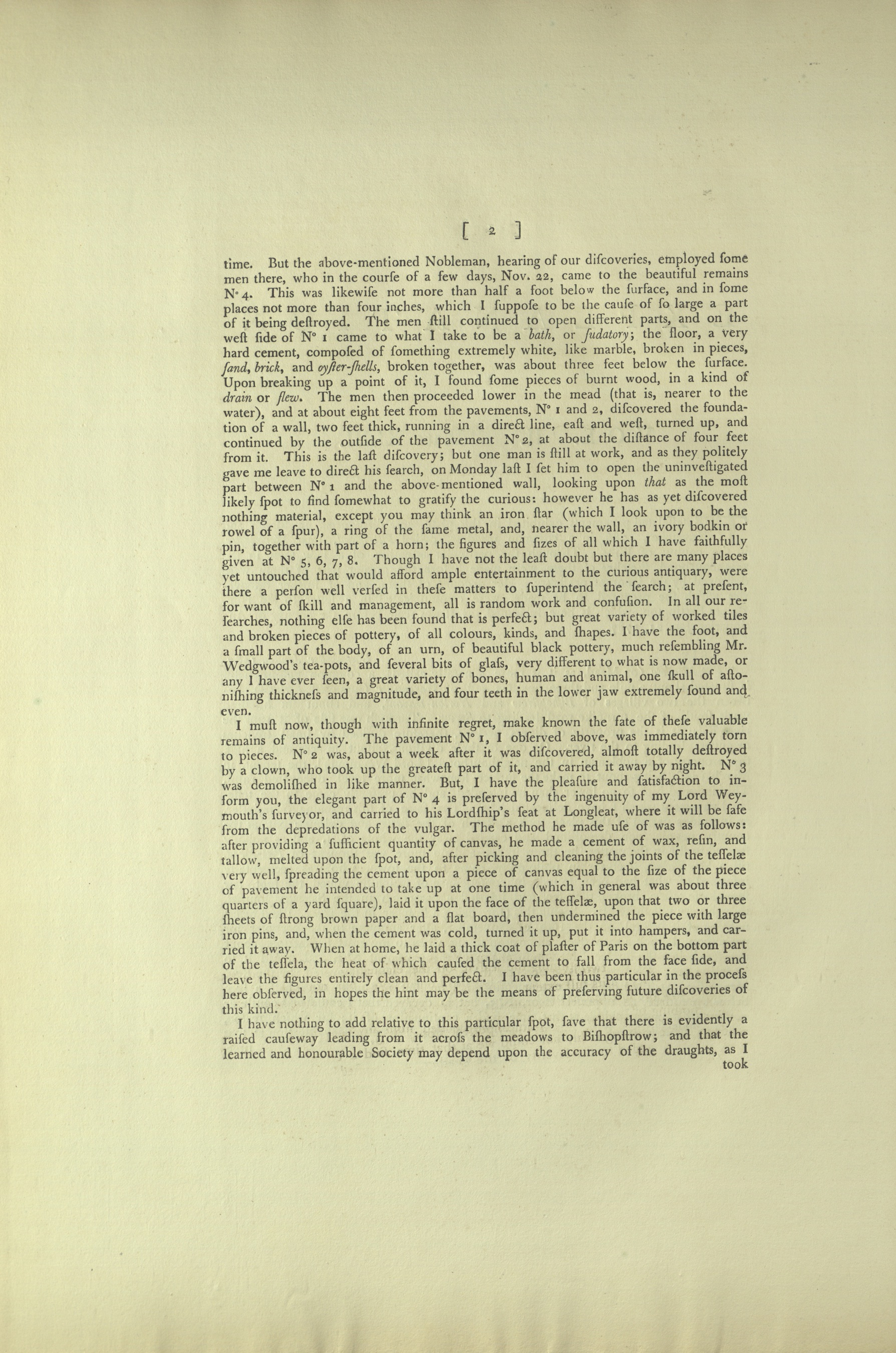
[ (Page) 2 ]
time. But the above-mentioned Nobleman, hearing of our discoveries, employed some men there, who in the course of a few days, Nov. 22, came to the beautiful remains No 4. This was likewise not more than half a foot below the surface, and in some places not more than four inches, which I suppose to be at the cause of so large a part of it being destroyed.
Read more/less…
The men still continued to open different parts, and on the west side of No 1 came to what I take to be a bath, or sudatory; the floor, a very hard cement, composed of something extremely white, like marble, broken in pieces, sand, brick, oyster-shells, broken together, what about three feet below the surface. Upon breaking up a point of it, I found some pieces of burnt wood, in a kind of drain or flew. The men then proceded lower in the mead (that is, nearer to the water), and at about eight feet from the pavements, No 1 and 2, discovered the foundation of a wall, two feet thick, running in a direct line, east and west, turned up, and continued by the outside of the pavement No 2, at about the distance of four feet from it. This is the last discovery; but one man is still at work, and as they politely gave me leave to direct his search, on Monday last I set him to open the uninvestigated part between No 1 and the above-mentioned wall, looking upon that as the most likely spot to find somewhat to gratify the curious: however he has as yet discovered nothing material, except you may think an iron star (which I look upon to be the rowel of a spur), a ring of the same metal, and, nearer the wall, an ivory bodkin or pin, together with part of a horn; the figures and sizes of all which I have faithfully given at No 5, 6, 7, 8. Though I have not the least doubt but there are many places yet untouched that would afford ample entertainment to the curious antiquary, were there a person well versed in these matters to superintend the search; at present, for want of skill and management, all is random work and confusion. In all our researches, nothing else has been found that is perfect; but great variety of worked tiles and broken pieces of pottery, of all colours, kinds, and shapes. I have the foot, and a small part of the body, of an urn, of beautiful black pottery, much resembling Mr. Wedgwood’s tea-pots, and several bits of glass, very different to what is now made, or any I have ever seen, a great variety of bones, human and animal, one skull of astonishing thickness and magnitude, and four teeth in the lower jaw extremely sound and even.
I must now, though with infinite regret, make known the fate of these valuable remains of antiquity. The pavement No 1, I observed above, was immediately torn to pieces. No 2 was, about a week after it was discovered, almost totally destroyed by a clown, who took up the greatest part of it, and carried it away by night. No 3 was demolished in like manner. But, I have the pleasure and satisfaction to inform you, the elegant part of No 4 is preserved by the ingenuity of my Lord Weymouth’s surveyor, and carried to his Lordship’s seat at Longleat, where it will be safe from the depredations of the vulgar. The method he made use of was as follows: after providing a sufficient quantity of canvas, he made a cement of wax, resin, and tallow, melted upon the spot, and, after picking and cleaning the joints of the tesselae very well, spreading the cement upon a piece of canvas equal to the size of the piece of pavement he intended to take up at one time (which in general was about three quarters of a yard square), laid it upon the face of the tesselae, upon that two or three sheets of strong brown paper and a flat board, then undermined the piece with large iron pins, and, when the cement was cold, turned it up, put it into hampers, and carried it away. When at home, he laid a thick coat of plaster of Paris on the bottom part of the tessela, the heat of which caused the cement to fall from the face side, and leave the figures entirely clean and perfect. I have been thus particular in the process he observed, in hopes the hint may be the means of preserving future discoveries of this kind.
I have nothing to add relative to this particular spot, save that there is evidently a raised causeway leading from it across the meadows to Bishopsrow; and that the learned and honourable Society may depend upon the accuracy of the draughts, as I
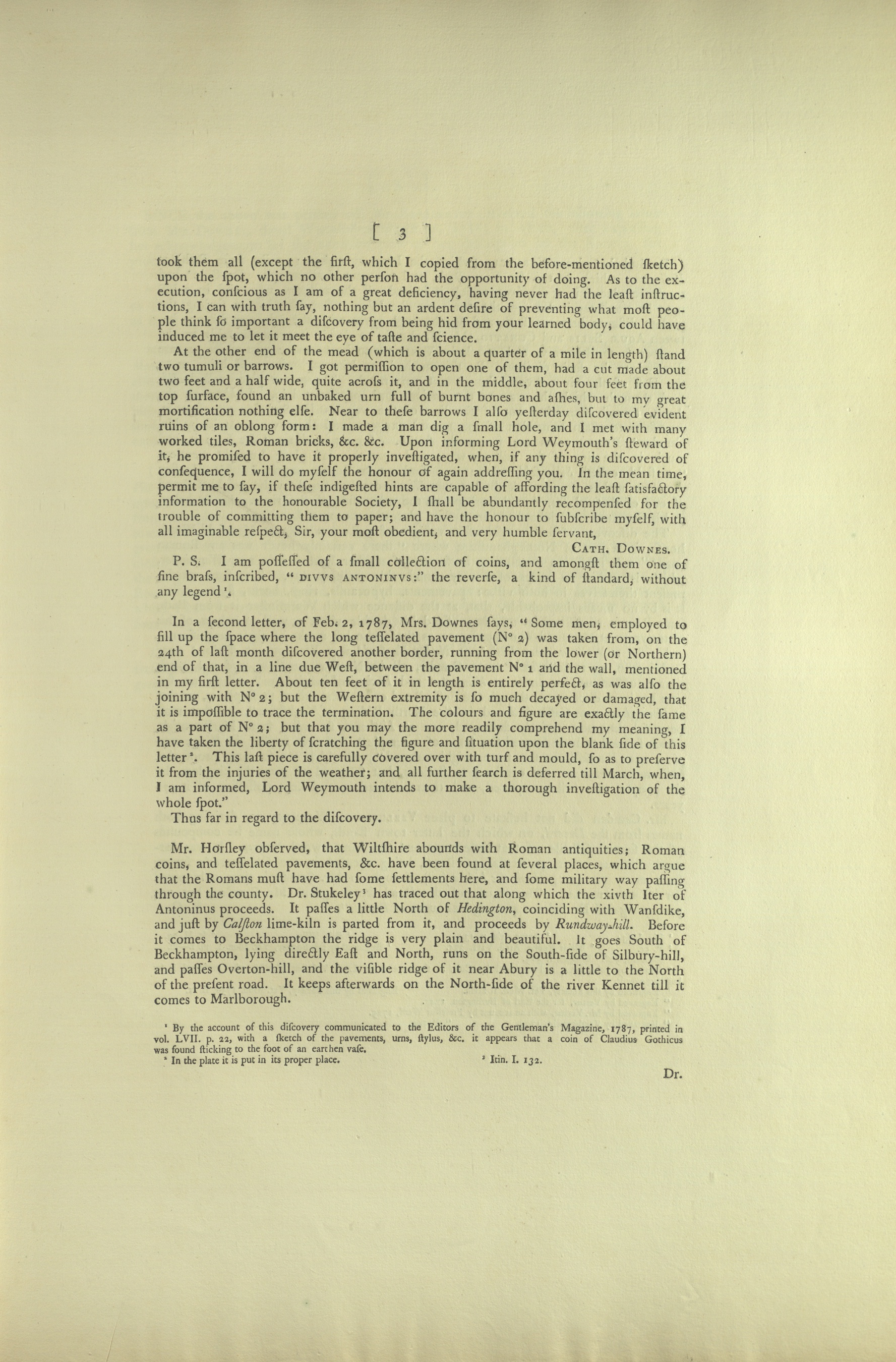
[ (Page) 3 ]
took them all (except the first, which I copied from the before-mentioned sketch) upon the spot, which no other person had the opportunity of doing. As to the execution, conscious as I am of a great deficiency, having never had the least instructions, I can with truth say, nothing but an ardent desire of preventing what most people think so important a discovery from being hid from your learned body, could have induced me to let it meet the eye of taste and science.
Read more/less…
At the other end of the mead (which is about a quarter of a mile in length) stand two tumuli or barrows. I got permission to open one of them, had a cut made about two feet and a half wide, quite across it, and in the middle, about four feet from the top surface, found an unbaked urn full of burnt bones and ashes, but to my great mortification nothing else. Near to these barrows I also yesterday discovered evident ruins of an oblong form: I made a man dig a small hole, and I met with many worked tiles, Roman bricks, &c. &c. Upon informing Lord Weymouth’s steward of it, he promised to have it properly investigated, when, if any thing is discovered of consequence, I will do myself the honour of again addressing you. In the mean time, permit me to say, if these indigested hints are capable of affording the least satisfactory information to the honourable Society, I shall be abundantly recompensed for the trouble of committing to paper; and have the honour to subscribe myself, with all imaginable respect, Sir, your most obedient, and very humble servant,
CATH. DOWNES.
P.S. I am possessed of a small collection of coins, and amongst them one of fine brass, inscribed, “DIVVS ANTONINVS:” the reverse, a kind of standard, without any legend1.[”]
In a second letter, of Feb. 2, 1787, Mrs. Downes says “Some men, employed to fill up the space where the long tesselated pavement (No 2) was taken from, on the 24th of last month discovered another border, running from the lower (or Northern) end of that, in a line due West, between the pavement No 1 and the wall, mentioned in my first letter. About ten feet of it in links is entirely perfect, as was also the joining with No 2; but the Western extremity is so much decayed or damaged, that it is impossible to trace the termination. The colours and figure are exactly the same as a part of No 2; but that you may the more readily comprehend my meaning, I have taken the liberty of scratching the figure and situation upon the blank side of this letter2. This last piece is carefully covered over with turf and mould, so as to preserve it from the injuries of the weather; and all further search is deferred till March, when, I am informed, Lord Weymouth intends to make a thorough investigation of the whole spot.”
Thus far in regard to the discovery.
Mr. Horsley observed, Wiltshire abounds with Roman antiquities; Roman coins, and tesselated pavements, &c. have been found at several places, which argue that the Romans must have had some settlements here, and some military way passing through the county. Dr. Stukeley3 has traced out that along which the xivth Iter of Antoninus proceeds. It passes a little North of Hedington, coinciding with Wansdike, and just by Calston lime-kiln is parted from it, and proceeds by Rundway-hill. Before it comes to Beckhampton the ridge is very plain and beautiful. It goes South of Beckhampton, lying directly East and North, runs on the South-side of Silbury-hill, and passes Overton-hill, and the visible ridge of it near Abury is a little to the North of the present road. It keeps afterwards on the North-side of the river Kennet till it comes to Marlborough.
1By the account of this discovery communicated to the Editors of the Gentleman’s Magazine, 1787, printed in vol. LVII. p. 22, withs a sketch of the pavements, urns, stylus, &c. it appears that a coin of Claudius Gothicus was found sticking to the foot of an earthen vase.
2In the plate it is put in its proper place.
3Itin. I. 132.
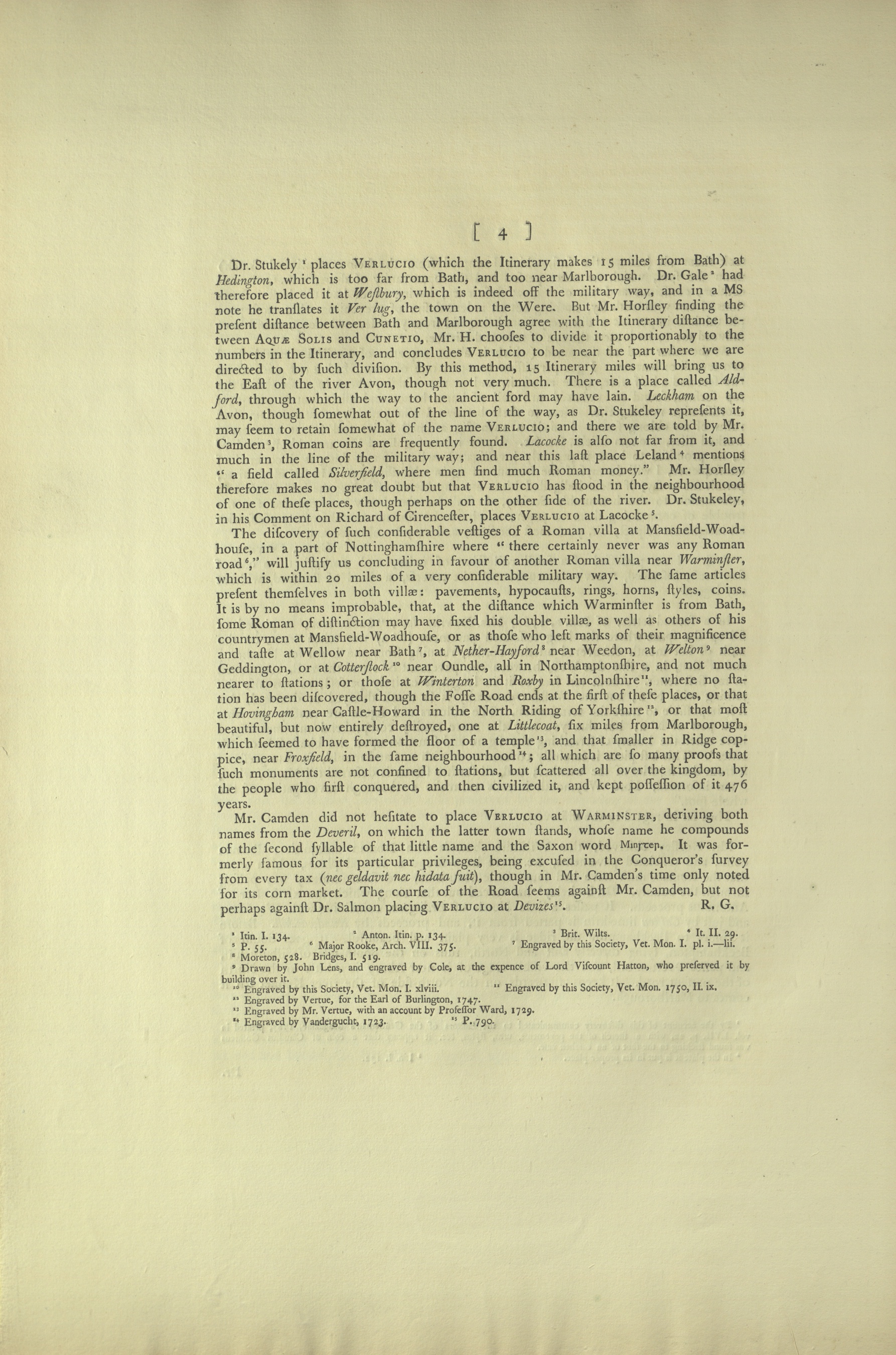
[ (Page) 4 ]
Dr. Stukely1 [sic] places VERLUCIO (which the Itinerary makes 15 miles from Bath) at Hedington, which is too far from Bath, and too near Marlborough. Dr. Gale2 had therefore placed it at Westbury, which is indeed off the military way, and in a MS note he translates it Ver lug, the town on the Were.
Read more/less…
But Mr. Horsley finding the present distance between Bath and Marlborough agree[s] with the Itinerary distance between AQUAE SOLIS and CUNETIO, Mr. H. chooses to divide it proportionably to the numbers in the Itinerary, and concludes VERLUCIO to be near the part where we are directed to by such division. By this method, 15 Itinerary miles will bring us to the East of the river Avon, though not very much. There is a place called Aldford, through which the way to the ancient ford may have lain. Leckham on the Avon, though somewhat out of the line of the way, as Dr. Stukeley represents it, may seem to retain somewhats of the name VERLUCIO; and there we are told by Mr. Camden3, Roman coins are frequently found. Lacocke is also not far from it, and much in the line of the military way; and near this last place Leland4 mentions “a field called Silverfield, where men find much Roman money.” Mr. Horsley therefore makes no great doubt but that VERLUCIO has stood in the neighbourhood of one of these places, though perhaps on the other side of the river. Dr. Stukeley, in his Comment on Richard of Cirencester, places VERLUCIO at Lacocke5.
The discovery of such considerable vestiges of a Roman villa at Mansfield-Woadhouse, in a part of Nottinghamshire where “there certainly never was any Roman Road6,” will justify us concluding in favour of another Roman villa near Warminster, which is within 20 miles of a very considerable military way. The same articles present themselves in both villae: pavements, hypocausts, rings, horns, styles, coins. It is by no means improbable, that, at the distance which Warminster is from Bath, some Roman of distinction may have fixed his double villae, as well as others of his countrymen at Mansfield-Woadhouse, or as those who left marks of their magnificence and taste at Wellow near Bath7, at Nether-Hayford8 near Weedon, at Welton9 near Geddington, or at Cotterstock10 near Oundle, all in Northamptonshire, and not much nearer to stations; or those at Winterton and Roxby in Lincolnshire11, where no station has been discovered, though the Fosse Road ends at the first of these places, or that at Hovingham near Castle-Howard in the North Riding of Yorkshire12, or that most beautiful, but now entirely destroyed, one at Littlecoat, six miles from Marlborough, which seemed to have formed the floor of a temple13, and that smaller in Ridge coppice, near Froxfield, in the same neighbourhood14; all which are so many proofs that such monuments are not confined to stations, but scattered all over the kingdom, by the people who first conquered, and then civilized it, and kept possession of it 476 years.
Mr. Camden did not hesitate to place VERLUCIO at WARMINSTER, deriving both names from the Deveril, on which the latter town stands, whose name he compounds of the second syllable of that little name and the Saxon word [transcription to be completed]. It was formerly famous for its particular privileges, being excused in the Conqueror’s survey from every tax (nec geldavit nec hidata fuit [translation to be completed]), though in Mr. Camden’s time only noted for its corn market. The course of the Road seems against Mr. Camden, but not perhaps against Dr. Salmon placing VERLUCIO at Devizes15. R. G. [Richard Gough]
1Itin. I. 134.
2Anton. Itin. p. 134.
3Brit. Wilts.
4It. II. 29.
5P. 55.
6Major Rooke, Arch. VIII. 375.
7Engraved by this Society, Vet. Mon. I. pl. i.—lii.
8Moreton, 528. Bridges, I. 519.
9Drawn by John Lens, and engraved by Cole, at the expence of Lord Viscount Hatton, who preserved it by building over it.
10Engraved by this Society, Vet. Mon. I. xlviii.
11Engraved by this Society, Vet. Mon. 1750, II. ix.
12Engraved by Vertue, for the Earl of Burlington, 1747.
13Engraved by Mr. Vertue, with an account by Professor Ward, 1729.
14Engraved by Vandergucht, 1723.
15P. 790.
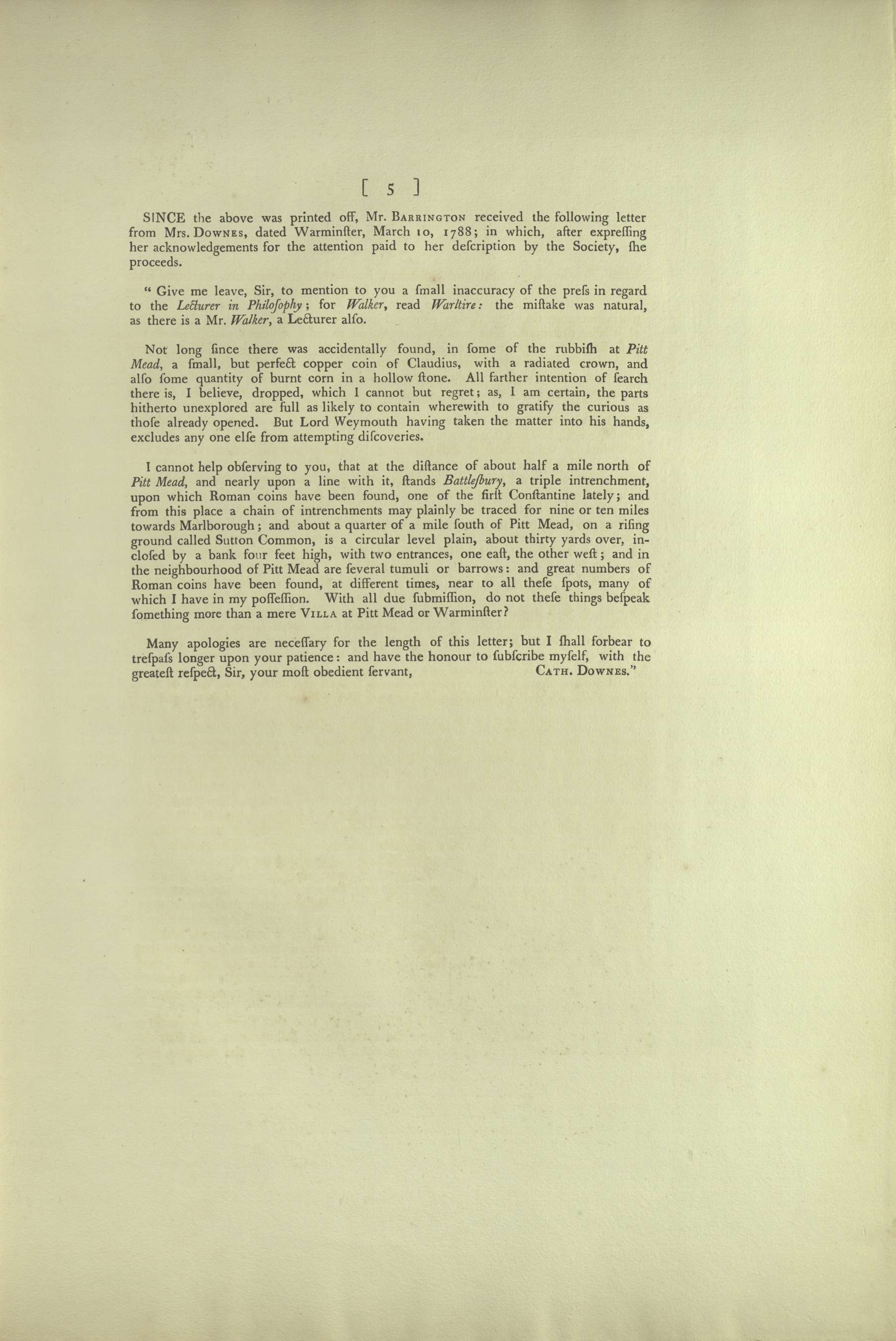
[ (Page) 5 ]
SINCE the above was printed off, Mr. BARRINGTON received the following letter from Mrs. DOWNES, dated Warminster, March 10, 1788; in which, after expressing her acknowledgements for the attention paid to her description by the Society, she proceeds.
Read more/less…
“Give me leave, Sir, to mention to you a small inaccuracy of the press in regard to the Lecturer in Philosophy; for Walker, read Warltire: the mistake was natural, as there is a Mr. Walker, a Lecturer also.
Not long since there was accidentally found, in some of the rubbish at Pitt Mead, a small, but perfect copper coin of Claudius, with a radiated crown, and also some quantity of burnt corn in a hollow stone. All farther intention of search there is, I believe, dropped, which I cannot but regret; as, I am certain, the parts hitherto unexplored are full as likely to contain wherewith to gratify the curious as those already opened. But Lord Weymouth having taken the matter into his hands, excludes any one else from attempting discoveries.
I cannot help observing to you, that at the distance of about half a mile north of Pitt Mead, and nearly upon a line with it, stands Battlesbury, a triple intrenchment, upon which Roman coins have been found, one of the first Constantine lately; and from this place a chain of intrenchments may plainly be traced for nine or ten miles towards Marlborough; and about a quarter of a mile south of Pitt Mead, on a rising ground called Sutton Common, is a circular level plain, about thirty yards over, inclosed by a bank four feet high, with two entrances, one east, the other west; and in the neighbourhood of Pitt Mead are several tumuli or barrows: and great numbers of Roman coins have been found, at different times, near to all these spots, many of which I have in my possession. With all due submission, do not these things bespeak something more than a mere VILLA at Pitt Mead or Warminster?
Many apologies are necessary for the length of this letter; but I shall forbear to trespass longer upon your patience: and have the honour to subscribe myself, with the greatest respect, Sir, your most obedient servant, CATH. DOWNES.”